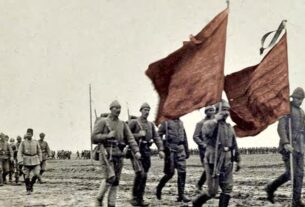Sun 12 May 2019:
While Assad regime forces have been fighting rebels over territory, his government was waging war against civilians
The New York Times offered special insight into the secret torture facilities of Bashar al-Assad’s regime in Syria, in a report published Saturday. While the Assad regime’s army has been fighting the rebel forces over territory, his government was waging an all-out war against its own civilians.
The exact number of civilians detained in these prisons is unknown, however, 128,000 Syrians are either considered to be detained or dead, according to the Syrian Network for Human Rights. Nearly 14,000 were killed from torture. “The millions of relatives of missing detainees float in a social and psychological limbo,” The Times wrote. Now, as the regime is nearing the end of a brutal and bloody eight-year conflict, the rate at which people are being detained in the country is increasing.

Satellite images show the increase in mass graves at a cemetery near Damascus between 2010, left, and 2016, right. Amnesty International said that bodies of prisoners executed in Saydnaya Prison were buried there.CreditAmnesty International, via Agence France-Presse — Getty Images
“Last year the Syrian Network recorded 5,607 new arrests that it classifies as arbitrary — more than 100 per week and nearly 25 percent more than the year before,” The Times wrote in the report. The newspaper found that government memos reveal that Syrian officials close to Assad had ordered mass detention and knew all about the atrocities taking place. Syria has been locked in a vicious civil war since early 2011, when the Bashar al-Assad regime cracked down on pro-democracy protests. Since then, hundreds of thousands of people have been killed and more than 10 million others displaced, according to UN officials.
In the past few months, the Assad regime has acknowledged the deaths of hundreds inside detention facilities, in what is a tactical strategy aimed at sending the message “We won, we did this, and no one will punish us,” according to the founder of the Syrian Network Fadel Abdul Ghany.
Rape and assault
Women and girls have been raped and sexually assaulted in at least 20 intelligence branches, and men and boys in 15 of those, a United Nations human rights commission reported last year. Sexual assault is a double-barreled weapon in traditional Muslim communities, where survivors are often stigmatized. Relatives have killed female ex-detainees in so-called honor killings, sometimes merely on the assumption they have been raped, rights reports and survivors say. Mariam Khleif, a 32-year-old mother of five from Hama, was repeatedly raped during her detention. Ms. Khleif said she had aided injured protesters and delivered medical supplies to rebels, acts that the government labeled terrorism.

Mariam Khleif, a mother of five, said she was repeatedly raped during a month in prison.
In September 2012, she said, security officers dragged her from her house. At state security’s Branch 320 in Hama, she said, the investigation chief introduced himself as Colonel Suleiman. CIJA’s archives show that Ms. Khleif was detained and that a Col. Suleiman Juma headed the Hama branch. “He was eating pistachios,” she recalled later in her sparse apartment in Reyhanli, Turkey. “He spat the shells at us. He left no dirty word unused.” A three-foot-square basement cell held her and six other women. Guards hung her from walls and beat her, knocking out teeth. She saw them drag a prisoner complaining of hunger to a toilet and stuff his mouth with excrement, a method recalled by other survivors. “At midnight,” she said, “they would take the beautiful girls to Colonel Suleiman to rape. I remember Colonel Suleiman and his green eyes.” Ms. Khleif identified the colonel in photographs of a security officer’s funeral. Then she broke down.
The colonel and friends — men in tracksuits — assaulted the women on a bed in a room adjoining his office, decorated with Mr. al-Assad’s photograph, she said. They splashed arak on the victims, a further insult to Muslims who abstained from alcohol. The women’s cell had no toilet. Blood from violent rapes stained the floor. One cellmate miscarried. By the time Ms. Khleif’s cousin made a deal to release her a month later, Ms. Khleif said, she had lost a third of her weight. She later fled to rebel territory as a medic.
Another female survivor separately told CIJA’s investigators that she had been raped by Colonel Juma the same month in the same prison. The details closely tracked Ms. Khleif’s account. Even women who were not raped reported groping, sexual insults, threats of rape to extract confessions, and cavity “searches.” In one Damascus facility, several survivors said separately, the chief investigator reserved for himself the job of digitally penetrating them. They called him Sharshabeel, the Arabic name for the evil wizard in “The Smurfs.” One, who covers her head, said he stroked her hair and naked body during interrogation, details she kept from her family.
Ms. Khleif’s family rejected her over what they considered her loss of honor and her politics, she said. Her pro-government brother texted death threats; her husband divorced her. For some conservative men, the conflict changed attitudes. Several survivors and male relatives say their families now honor sexual assault survivors as war wounded. Ms. Khleif hid nothing from her new husband, a former rebel. “You are a medal on my chest, you are the crown on my head,” she recalled him telling her. “He cooked for me, massaged my face with oil. He made me my old self.”
– Cases of torture
The newspaper documented numerous cases of torture at the hands of the regime. Many of these cases took place at Saydnaya Prison, which is known in Syria as the place where prisoners were sent in mass to face executions. One of the extreme cases was of Muhannad Ghabbash, a student from Aleppo, who was arrested multiple times in the beginning of Syria’s civil war. After his third arrest, he faced a harsh series of beatings, and would sometimes “wake up naked in a freezing hallway,” and have a gun put into his mouth by an officer.
Another torture survivor said he witnessed “a teenager take 21 days to die after interrogators doused him with fuel and set him alight.” One guard, who called himself Hitler, would organize a “sadistic dinner entertainment” in which he would force inmates to act as animals, making them bark like dogs or crow like roosters. “The dog has to bark, the cat meow, the rooster crow,” Ghabbash told The Times. “Hitler tries to tame them. When he pets one dog, the other dog should act jealous.” Inside the walls of these secret prison facilities, rape and sexual assault are also rampant.
Last year, a UN human rights commission report said that women and girls had been raped and sexually assaulted in at least 20 intelligence branches in the country, and men and boys in 15 branches. The women who were not raped had reported facing groping, sexual insults, threats of rape, and cavity searches, according to the Times. The UN has also noted that the unhealthy conditions of the detention centers are so extreme and systemic that “they amounted to extermination, a crime against humanity.” Any hopes at holding the Assad regime accountable remain bleak, however, there is an increase in the movement to find justice through European courts. International arrest warrants for Ali Mamlouk, Assad’s national security chief, and Air Force intelligence director Jamil Hassan were issued by French and German authorities over the cases of torture and death in these prisons.
Think your friends would be interested? Share this story!





